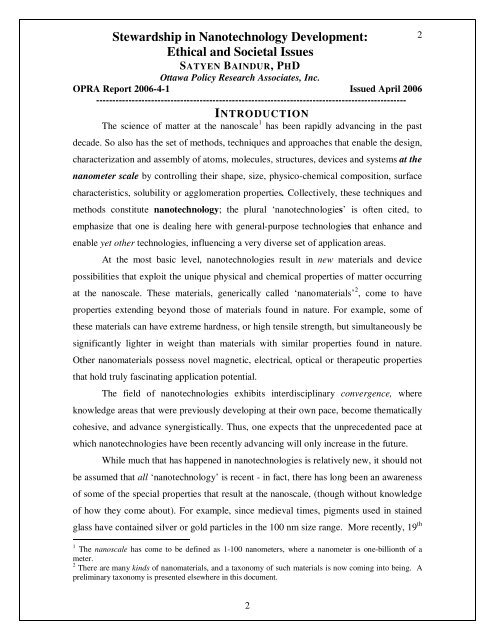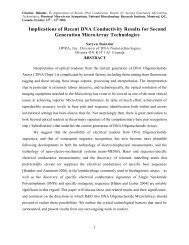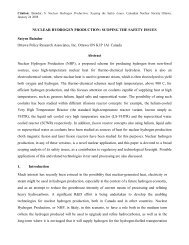Development Ethical and Societal Issues Satyen Baindur PhD
Ethical and Societal Issues - Satyen.Baindur.Org
Ethical and Societal Issues - Satyen.Baindur.Org
Create successful ePaper yourself
Turn your PDF publications into a flip-book with our unique Google optimized e-Paper software.
Stewardship in Nanotechnology <strong>Development</strong>:<br />
<strong>Ethical</strong> <strong>and</strong> <strong>Societal</strong> <strong>Issues</strong><br />
SATYEN BAINDUR, PHD<br />
Ottawa Policy Research Associates, Inc.<br />
OPRA Report 2006-4-1 Issued April 2006<br />
------------------------------------------------------------------------------------------------<br />
INTRODUCTION<br />
The science of matter at the nanoscale 1 has been rapidly advancing in the past<br />
decade. So also has the set of methods, techniques <strong>and</strong> approaches that enable the design,<br />
characterization <strong>and</strong> assembly of atoms, molecules, structures, devices <strong>and</strong> systems at the<br />
nanometer scale by controlling their shape, size, physico-chemical composition, surface<br />
characteristics, solubility or agglomeration properties. Collectively, these techniques <strong>and</strong><br />
methods constitute nanotechnology; the plural ‘nanotechnologies’ is often cited, to<br />
emphasize that one is dealing here with general-purpose technologies that enhance <strong>and</strong><br />
enable yet other technologies, influencing a very diverse set of application areas.<br />
At the most basic level, nanotechnologies result in new materials <strong>and</strong> device<br />
possibilities that exploit the unique physical <strong>and</strong> chemical properties of matter occurring<br />
at the nanoscale. These materials, generically called ‘nanomaterials’ 2 , come to have<br />
properties extending beyond those of materials found in nature. For example, some of<br />
these materials can have extreme hardness, or high tensile strength, but simultaneously be<br />
significantly lighter in weight than materials with similar properties found in nature.<br />
Other nanomaterials possess novel magnetic, electrical, optical or therapeutic properties<br />
that hold truly fascinating application potential.<br />
The field of nanotechnologies exhibits interdisciplinary convergence, where<br />
knowledge areas that were previously developing at their own pace, become thematically<br />
cohesive, <strong>and</strong> advance synergistically. Thus, one expects that the unprecedented pace at<br />
which nanotechnologies have been recently advancing will only increase in the future.<br />
While much that has happened in nanotechnologies is relatively new, it should not<br />
be assumed that all ‘nanotechnology’ is recent - in fact, there has long been an awareness<br />
of some of the special properties that result at the nanoscale, (though without knowledge<br />
of how they come about). For example, since medieval times, pigments used in stained<br />
glass have contained silver or gold particles in the 100 nm size range. More recently, 19 th<br />
1 The nanoscale has come to be defined as 1-100 nanometers, where a nanometer is one-billionth of a<br />
meter.<br />
2 There are many kinds of nanomaterials, <strong>and</strong> a taxonomy of such materials is now coming into being. A<br />
preliminary taxonomy is presented elsewhere in this document.<br />
2<br />
2










